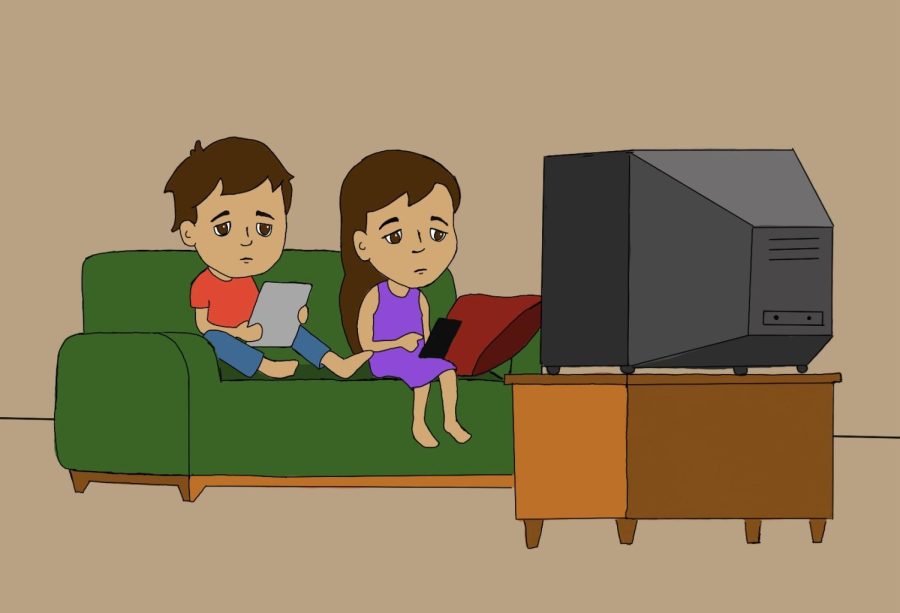Video Killed the Radio Star but Streaming Isn’t Too Far Behind
Philosopher Marshall McLuhan characterized technological advancements as extensions and amputations. For example, before television, there was the radio, before radio, there was print, and before print, there was word of mouth. When we made the move from radio to television, we gained visuals but in turn required users to dedicate two senses to the medium of television.
March 1, 2023
Arising from a needed distraction in the face of a numb slog, I tried to wean myself off of the habit of streaming services as a whole. I no longer felt the same engagement or enjoyment I once had. Fortunately, that didn’t last long.
But something still bugged me.
Streaming platforms have given way to a renaissance for sitcoms long after their final airing, reintroducing shows like “The Office” or “Friends” to younger generations, yet, a trademark of television sitcoms is disappearing: the laugh track. A holdover from the transition from radio to television where the setting and pace of shows were usually suited to live audiences, the laugh track is disappearing and is a sign of a shift in media.
This is not an argument based on nostalgic memories that never existed for my generation who were too young to remember shows like “Seinfeld,” but the future of sitcoms and network television is being left in the dust with different platforms vying for dominance.
Will the laughs go silent?
Streaming media has taken the place that television had in the homes of millions as a means of entertainment and information. As a consequence, it has become harder to recognize a common bond across different demographics as technology has become less centralized. Moreover, storytelling and viewing habits have become more personalized, but television remains unshaken in offering more objective and accessible content.
But, for how much longer?
Getting its start as a mail-order DVD rental website in 1997, a service it still provides today and whose premise may confuse younger readers, Netflix became a trailblazer in the sector when it launched its streaming service in 2007.
Today, 6-in-10 young adults primarily use streaming to view television, and two-thirds get their news from social media sites according to the Pew Research Center.
Streaming offers consumers the ability to watch what they want to watch, when they want to watch it. Storytelling has ceased to be communal as it has become easier to isolate oneself and still be entertained without the compromise of commercials.
What made Netflix so successful in its beginnings was the novelty of being a one-stop shop streaming service. Countless hours of licensed content could be accessed with ease in exchange for a relatively menial subscription fee.
But, in a struggle of attrition, the streaming wars have given way to no clear victor; instead, scorched earth.
Leading up to the COVID-19 pandemic, a rogues’ gallery began to form with well-established names in entertainment like Paramount, the Walt Disney Company, and Warner Bros. Pictures throwing their hats into the ring by creating their own competing streaming services. Even tech giants Amazon and Apple have given it a go.
Streaming services have canceled projects as if they were fodder in the fight for more subscribers, regardless of critical acclaim and outcry from fans. As growth stalled among rivals in the post-pandemic world, streaming services are looking to cut their losses by prioritizing shows that fit into the binge-watching habit that streaming is known for.
The wax wings of streaming have proven too much under the weight of its own inflated success, and consumers have suffered as a result.
In addition to this content frenzy, services have resorted to increasing subscription prices, cracking down on account sharing, and even introducing ad-supported plans. A standard Netflix subscription in 2011 only cost $8; but now the most popular plan, the standard plan, costs $15.49 a month.
But with titles returning to their original distributor’s own streaming service, original content has come into its own.
While it is easy to point out how problematic or unrealistic depictions of life are in most sitcoms, it is for these reasons that sitcoms can play an important role, acting as a mirror and testament to the values of contemporary life, usually through satire.
Shows with moral ambiguity, intricate plots, and complex characters have been able to thrive under a streaming system as they no longer had to appeal to the whole family to be successful, nor were they staggered by commercials.
Shows whose phenomenal success was enabled by streaming with the likes of “Euphoria” and “Heartstopper” on HBO Max and Netflix, respectively, were received with much fanfare for their diverse characters and candid depictions of issues among young adults.
Representation in media can affirm identity and also has the ability to inform and educate people about contrasting realities for different groups; however, is this representation reaching an audience where it could make the most difference?
Herded by targeted recommendations using algorithms, streaming services will personalize the content presented to you. Netflix, for example, tailors recommendations which “strives to help you find a show or movie to enjoy with minimal effort” based on a number of factors including: your interactions with their service such as your viewing history and how you rated other titles, other customers with similar tastes and preferences on their service, and information about the titles, such as their genre, categories, actors, and release year.
Streaming services have purposely targeted specific groups, pigeonholing consumers into isolated niches with recommended content that is meant to appeal to certain demographics. Therefore, viewers are less likely to go beyond their comfort zone or titles presented to them by streaming services.
In contrast, viewers were limited in the variety of programming with television. If one were to find a show they liked, they would shape their schedule around the time of its showing as if it were a ritual.
Broadcast television thrived, as programming is supported by advertising, drives consumer culture — for better or worse — and has cemented itself as a part of American life as a means of information and entertainment because of its accessibility. In 1950, only nine percent of American households owned a television set, but, in the span of a decade, this jumped to nearly 90 percent.
From the local news hour or a syndicated show, to important hallmark events like the Olympics, Award shows, or the Super Bowl, network television has always been there to create those moments.
But outside of these events, streaming dominates as the go-to platform for entertainment.
Chances are, we are never going to return to a golden age of television. Television tries to please too many people all at once, and streaming is just more convenient. But, we cannot allow television to be the next lost medium.
Since the dawn of television, the big three networks — the National Broadcast Corporation (NBC), the Columbia Broadcasting System (CBS), and the American Broadcasting Corporation (ABC) — have served as cornerstones of American entertainment and news.
Accessible television would be further strengthened by the likes of the Public Broadcasting System (PBS), designed to be free from commercial influence thanks to government funding and viewers like you and me.
Local television stations like KATU, KOIN, KGW, OPB, and KPTV are still a hub for news, proving themselves during the COVID-19 pandemic, and remaining the primary source for vital information.
With all progress, we must ask ourselves what we are gaining and losing.





